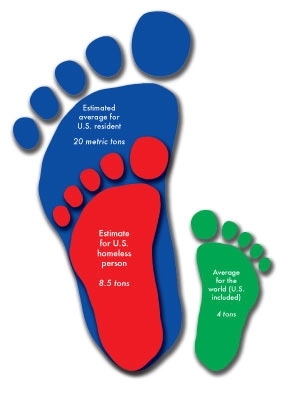Whether you live in a cardboard box or a luxurious mansion, whether you subsist on homegrown vegetables or wolf down imported steaks, whether you're a jet-setter or a sedentary retiree, anyone who lives in the U.S. contributes more than twice as much greenhouse gas to the atmosphere as the global average, an MIT class has estimated.
The class studied the carbon emissions of Americans in a wide variety of lifestyles--from the homeless to multimillionaires, from Buddhist monks to soccer moms--and compared them to those of other nations. The somewhat disquieting bottom line is that in the United States, even people with the lowest energy usage account for, on average, more than double the global per-capita carbon emission. And those emissions rise steeply from that minimum as people's income increases.
"Regardless of income, there is a certain floor below which the individual carbon footprint of a person in the U.S. will not drop," says Timothy Gutowski, professor of mechanical engineering, who taught the class that calculated the rates of carbon emissions. The results will be presented this May at the IEEE International Symposium on Electronics and the Environment in San Francisco.
While it may seem surprising that even people whose lifestyles don't appear extravagant--the homeless, monks, children--are responsible for significant greenhouse gas emissions, one major factor is the array of government services that are available to everyone in the United States. These basic services--including police, roads, libraries, the court system and the military--were allocated equally to everyone in the country in this study. Other services that are more specific, such as education or Medicare, were allocated only to those who actually make use of them.
The students conducted detailed interviews or made detailed estimates of the energy usage of 18 lifestyles, spanning the gamut from a vegetarian college student and a 5-year-old up to the ultrarich--Oprah Winfrey and Bill Gates. The energy impact for the rich was estimated from published sources, while all the others were based on direct interviews. The average annual carbon dioxide emissions per person, they found, was 20 metric tons, compared to a world average of four tons.
But the "floor" below which nobody in the U.S. can reach, no matter a person's energy choices, turned out to be 8.5 tons, the class found. That was the emissions calculated for a homeless person who ate in soup kitchens and slept in homeless shelters.
The analysis was carried out by Gutowski and 21 students in his 2007 class, "Environmentally benign design and manufacturing." They derived a system for making such comparisons, which they call ELSA--environmental life style analysis.
Unlike some other attempts to quantify carbon-emission rates, Gutowski and his students took great care to account for often-overlooked factors, such as the "rebound effect." That's when someone makes a particular choice--for example, buying a hybrid car instead of a gas-guzzler--but then uses the money saved from their reduced gasoline costs to do something else, such as taking a long trip by airplane. The net impact, in such a case, may actually be an overall increase in carbon emissions.
"When you save energy, you save money," Gutowski explains. "The question is, how are you going to spend that money?"
The students looked at the factors within each person's control that might lead to a reduction in carbon output. They found that achieving significant reductions for the most part required drastic changes that would likely be unacceptable to most people. As a result, they said, "this all suggests to us very significant limits to voluntary actions to reduce impacts, both at a personal level and at a national level."
In a continuation of the class this semester, another group of students are exploring this question in more detail, looking at just what kinds of things people really can do to limit their environmental impact. The question they are addressing, Gutowski says, is "can average Americans tighten their belts" in a way that would make a significant difference? Once again, the class will be interviewing people living in a wide variety of ways, including an Amish farming lifestyle. Then, after analyzing the results and possible changes, they will go back to the same people and ask, "Would you consider these alternatives?"
In general, spending money on travel or on goods that have substantial energy costs in their manufacture and delivery adds to a person's carbon footprint, while expenditures on locally based labor-intensive services--whether it's going to a therapist, taking an art class, or getting a massage--leads to a smaller footprint.
But the biggest factors in most people's lives were the obvious energy-users: housing, transportation and food. "The simple way you get people's carbon use down is to tax it," Gutowski says. "That's a hard pill to swallow--politicians don't like to step up" to support such measures. Absent such national actions, he says, it is important to study "what role consumer choices can play" in lowering the nation's carbon emissions.
If nothing else, the members of this class got a whole new perspective. "The students really got into it," Gutowski says. "It raised everybody's awareness about the issues."
A version of this article appeared in MIT Tech Talk on April 16, 2008 (download PDF).






